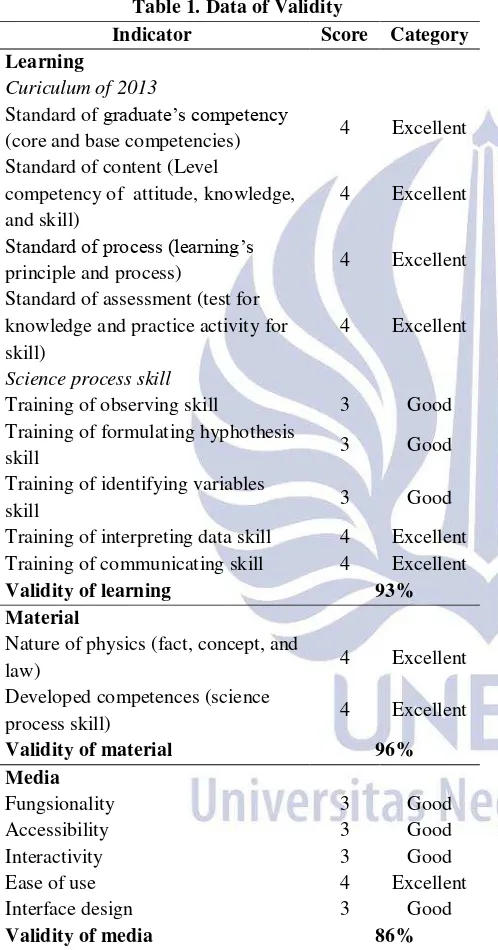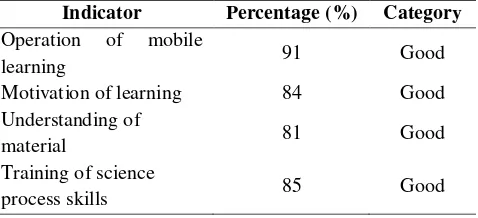DEVELOPMENT OF ANDROID MOBILE LEARNING USING APP INVENTOR TO TRAIN
HIGH SCHOOL STUDENT’S SCIENCE PROCESS SKILL
Zahrotul Ula Irma, Rudy Kustijono
Physics Education, Faculty of Mathematics and Natural Sciences, State University of Surabaya
Email:
zahrotululairma@gmail.com
Abstract
The purpose of research is to develope android mobile learning using app inventor to train high school
students's science process skill which feasible (valid, practical, and effective). The type of research is
development research of ADDIE’s model (Analysis, Design, Development, Implementation, and
Evaluation). The subject of research are 20 students of XI grade SMA Muhammadiyah 9 Surabaya. The
technique of data collection are questionnaire and observation. Mobile learning is declared feasible if
percentage of validity (learning, material, media), practicality (learning
’s
implementation is 93% with the
constraint that faced was sometimes application stopped suddenly)
, and effectiveness (students’s science
process skills and responses
) are ≥ 61% with good and excellent category.
The result of research shows the
validity of mobile learning is excellent (learning 93%, material 96%, and media 86%), the practicality is
excellent (learning
’s
implementation 93%) and the constraint that faced is sometimes application stopped
suddenly, and effectiveness is good (observing 100%, formulating hypotheses 65%, identifying variables
100%, interpreting data 65%, communicating 65% and students’s response are positive with percentage
between 81% and 91%. Research conclude that android mobile learning using app inventor can train high
school students’s science process skill.
Keywords:
mobile learning, android, and science process skills.
INTRODUCTION
The realities of globalization, knowledge work, and
accelerating societal change in 21
stcentury demand
educational system to equip students with the 21
stcentury
skills. It is important for students to overcome the
challenges of the 21
stcentury. The skills that needed in
21
stcentury are digital age literacy, inventive thinking,
effective communication, and high productivity (NCREL
2003). A part of digital age literacy is scientific literacy.
Scientific literacy is knowledge and understanding of the
scientific concepts and processes required for personal
decision making, participation in civic and cultural
affairs, and economic productivity (NRC, 1996). In
scientific literacy, there is science process which have
done by students to apply their knowledge. To do science
process, they need the skills, that is science process skills.
Science process skills are thinking and psychomotor
skills which used to discover, develop, and apply
knowledge. Science process skills involve intellectual,
psychomotor, and affective skills which are related to the
learning of science in all its aspects and derived from
fundamental abilities of students (Sheeba, 2013).
Therefore, science process skill isn’t instructional actions
out of students’s
ability, but it is intended to develop the
capabilities which possessed by students. Learning using
science
process
skill
allows
students to
learn
independently and allows students to be more active and
creative because students are asked to find knowledge
using their capabilities. When students use science
process skill to find knowledge, it’s means that students
Technology (ICT) of education, where technological
literacy is the other part of digital era literacy skills that
must be mastered by student to thrive in the 21
stcentury.
Nowday, technology is being a part of the students’s life
which is used to make student closer to their daily
phenomena. So, it can be integrated with learning of
science to improve the quality and efficiency of
education. It also nurture science process skills indirectly
(Turiman, et all., 2012). Mobile learning involves
learning through animated explanations, where more
often use of animation in learning process, more enhance
the learning process (Najjar, 1998). So, through
animation such as of scientific concepts and scientific
methods, quizzes, activities, virtual experiments, etc can
increase th
e capacity of students’s science process skills.
Mobile learning is applied to mobile applications, where
mobile application can minimize learning gap between
students with different spatial ability level (June-Yi
Wang, et all., 2017). It is needed in physics learning
because spatial ability is related to the capacity of
students to generate, imagine, retain or manipulate
images (Yilmaz, 2009), and students with high spatial
skills tend to show better result in physics (Kozhevnikov,
et all., 2007). Mobile learning can be applicated to
mobile application that runs in an operating system.
Nowdays, operating system that are growing rapidly and
widely used is android. One of the android tool software
maker is app inventor. It is a visual block programming
tool
, so it doesn’t need codes to make application. User
only use, arrange, and drag-drop visual object to create
application. Based on explanation before, it is important
to develope android mobile learning using app inventor
to train high school students’s s
cience process skill which
feasible. Feasible is involve validity, practicality, and
effectiveness (Akker, et al., 1999). Validity is defined as
compatibility of mobile learning with the study of
learning, material, and media. Practicality is defined as
the success of other users using mobile learning in
learning. Effectiveness is defined as the success of
mobile learning to train science process skills.
Science process skills that be train in this mobile
learning
are
observing,
formulating
hypotheses
identifying
variables,
interpreting
data,
and
communicating. Observing is defined as a process to
gather information using senses. It is the most basic skill
(Turiman, et all., 2012). The outcome of observing skill
are identifying and describing the characteristic of object
or event. Formulating hypothesis means that giving
prediction about experiment result that will be conducted
or answer prediction from problem. Hypotheses can be
meaned as prediction about effect which given by
manipulated variable to response variable (Rezba, et al.,
1995). The prediction must be based on the result
observasion or theories. Identifying variable skills are skill
to identify manipulate, response, and control variable.
Manipulated variable are variable which be changed and
be investigate its effect. Response variable is variable
which its value change as the effect of manipulate
variable’s change. Control variable is variable which can
affect the experiment result, but it control
s so that can’t
give the effect. Interpreting data means organizing and
analyzing data which gain by collecting infomation about
object or event which describe special condition, then
making conclusion based on the relation between variable
in the data in form of table or graphic (Sheeba, 2013).
Communicating is the process of presenting information..
It can take many forms including using words, action,
table or graphic (Turiman, et al., 2012).
Mobile learning has become widespread. Education
institutions started adopting mobile technology to cope
stu
dents’
s needs. The advantages of mobile learning is
gives learn anytime and anywhere, reach out to students
and schools which lacking learning facilities, improves
high-level thinking skills, provides new learning
environment alternative, provides wider access learning,
provides personalized learning, allows self-regulated
learning, makes student-centered learning, good for
review learning content, helps to facilitate different
learning needs among students, improve interaction
between students or between students and teacher, and
reducing communication barriers, provides useful features
for learning (McQuiggan, et al., 2015; Sarrab, et al., 2012;
Sha, et al., 2012; Ally, Mohamed, 2009; ). Mobile
learning also has weakness associated with mobile
devices, including small screen size, limited memory
capacity, limited battery life, limited applications and
software, lack of built-in functionality, difficulty adding
applications, differences between applications and the
usage condition, network speed, security and external
factors problem, and the challenge to design learning
using mobile devices (Kukulska-Hulme & Traxler, 2005).
Mobile learning which develop in this research is design
to android operating system. Android is a Linux-based
operating system designed for touch-screen mobile
devices such as smartphones and tablet PC. Nowdays, it a
widely used and growing rapidly operating system. One of
the reason for the rapidly growth of android is because the
operating system is open source so that freely distributed
and used by any vendor. Android is an operating system
that provides many software maker tools and allows for
application development.
puzzle to program it; and (3) the event handler makes it
easy to handle the event directly by retrieving drag and
drop block that handles the event, so there is no need to
understand classes, objects, and special objects to express
an event. In addition have advantages, app inventor also
has weakness, included: (1) less flexibility in designing
user interface and application commands; (2) when there
is a warning notice, it should find its own error location,
and (3) can’t create file which more than 10 MB.
METHODS
The type of research is development research of
ADDIE’s model (Analysis, Design,
Development,
Implementation, and Evaluation). This is procedure of
this research are showed by picture 1.
The first stage is analysis which included analysis of
curriculum standards of 2013, science process skills,
learning material, learning content, and mobile learning
system quality. The results of analysis is used to design
learning process in the second stage. The design refer to
the study of learning (curriculum of 2013 and science
process skills), the study of material (nature of physics
and developed competencies), and the study of media
(mobile learning system quality). The design of mobile
learning is reliazed in the development stage and then it
validated by experts of learning, material, and media to
test its validity. After mobile learning declare valid which
mean that mobile learning is feasible conceptually, it
implemented. The pupose of the implemantation stage is
to test the feasibility of mobile learning to be
implemantated in the real learning. It implementated to
the students, who are the subject of this research, they are
20 students of XI grade SMA Muhammadiyah 9
Surabaya. After that is the stage of evaluation. This stage
is to test the practicality and effectiveness of mobile
larning based on the stage of implemantation. Practicality
is reviewed from
learning’s implementation and
constraint. Effectiveness is reviewed from s
tudents’s
science process skills and responses.
The technique of data collection are questionnaire and
observation. Questionnaire is used to evaluate the validity
of learning, material, and
media, and also the students’s
responses. Observation is used to evaluate
the learning’s
implementation and constraint
, and also the students’s
science process skills. Assessment of all techniques uses
Likert scale (1=very poor, 2=poor, 3=good, and
4=excellent).
The instruments of validity are validation sheet of
learning, material, and media. Validation sheet of
learning assess compatibility of mobile learning with
curriculum of 2013 (
graduate’s competency
, content,
process, and assessment) and science process skills
(observing, formulating hypotheses, identifying variables,
interpreting data, and communicating). Validation sheet
of material assess compatibility of mobile learning with
nature of physics (facts, concepts, and laws of
electromagnetic induction) and developed competencies
(knowledge and skill). Validation sheet of learning assess
compatibility of mobile learning with mobile learning
system quality (functionality, accessibility, interactivity,
ease of use, and interface design).
The instrument of practicality is observation sheet of
learning’s implementation and constraint. It
assess
implementation of opening activity (motivation, learning
objective, and
material
coverage), core activity
(instruction on science process skills and material
explanation), and closing activity (feedback and test).
The instruments of effectiveness are observation
sheet of science process skills and questionnaire sheet of
student’s responses. Observation sheet of science process
skills assess all of student
’s skills of
observing,
formulating
hypotheses,
identifying
variables,
interpreting data, and communicating. Questionnaire
sheet of student’s responses
assess responses of operation
of mobile learning, motivation of learning, understanding
of material, and training of science process skills.
Mobile learning is declared feasible (valid, practical,
and effective) if percentage of validity (learning,
material, media), practicality (learning
’s
implementation
and constraint), and effectiveness (students
’
s science
Implementation
No Yes
No Yes
Analysis
Design
Development
Validation
Revision
Implementation
Evaluation
Revision
Product
Development Analysis
Design
Evaluation

